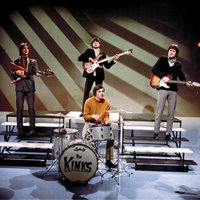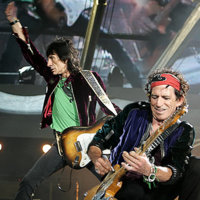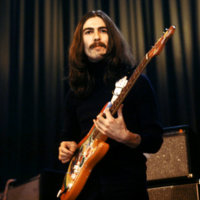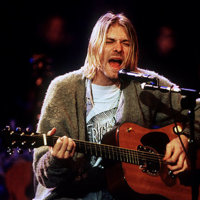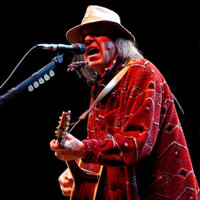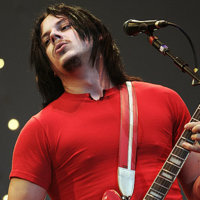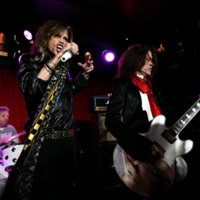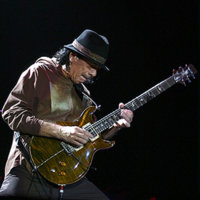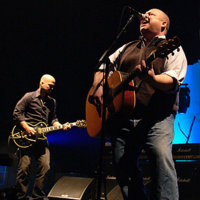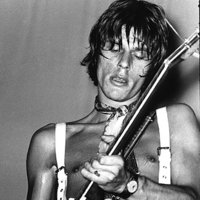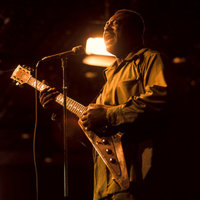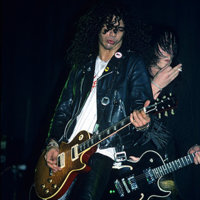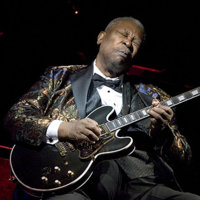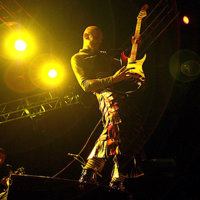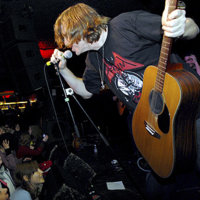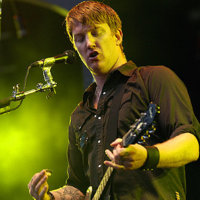This is what makes a great rock & roll guitar sound: an irresistible riff; a solo or jam that takes you higher every time you hear it; the final power chord that pins you to the wall and makes you hit "play" again and again. Every song here has those thrills. But these are rock's greatest guitar moments because of what's inside the notes: hunger, fury, despair and joy, often all at once. You hear the blues, gospel and rockabilly that came before, transormed by the need to say something new and loud, right away. Rock & roll has been the sound of independence for half a century. The guitar is still its essential, liberating voice. These are the 100 reasons why.
(Rolling Stone.com)
1 [FONT=Georgia, Verdana]"Johnny B. Goode"[/FONT]
Chuck Berry (1958)
"If you want to play rock & roll," Joe Perry told Rolling Stone in 2004, "you have to start here." Recorded 50 years ago, on January 6th, 1958, at the Chess Records studio in Chicago, Berry's "Johnny B. Goode" was the first great record about the joys and rewards of playing rock & roll guitar. It also has the single greatest rock & roll intro: a thrilling blast of high twang driven by Berry's spearing notes, followed by a rhythm part that translates a boogie-woogie piano riff for the guitar. "He could play the guitar just like a-ringing a bell," Berry sings in the first verse a perfect description of his sound and the reverberations still running through every style of rock guitar, from the Beatles and the Stones on down. "It was beautiful, effortless, and his timing was perfection," Keith Richards has said of Berry's playing. "He is rhythm man supreme." Berry wrote often about rock & roll and why it's good for you "Roll Over Beethoven" in 1956, "Rock and Roll Music" in '57 but never better than in "Johnny B. Goode," a true story about how playing music on a guitar can change your life forever.
http://www.youtube.com/watch?v=R0YUA3yTUss
2 [FONT=Georgia, Verdana]"Purple Haze"[/FONT]
The Jimi Hendrix Experience (1967)
The riff is pure blues the same kind of guitar figure Hendrix played nightly back on the R&B-club grind, as a sideman for Little Richard and the Isley Brothers. But in "Purple Haze," Hendrix's second British single and the first track on the U.S. version of his debut album, he declared himself a free man "'Scuse me while I kiss the sky" and unveiled a new guitar language charged with spiritual hunger and the poetry possible in electricity and studio technology. "Guitar you can play it or transcend it," said Neil Young when he inducted Hendrix into the Rock & Roll Hall of Fame in 1992. "Jimi showed me that. I heard it, felt it and wanted to do it." Hendrix wrote "Purple Haze" backstage at a London nightclub in December 1966 and recorded basic tracks with his band, the Experience, two weeks later. But the galactic travel came in overdubs recorded on February 3rd, 1967: Hendrix's solos, swimming in echo and sparkling with harmonics, were put through an octave-boosting effect and played back at twice the speed. In less than three minutes, Hendrix opened a new age of expression on his instrument.
http://www.youtube.com/watch?v=cnFSaqFzSO8
3 [FONT=Georgia, Verdana]"Crossroads"[/FONT]
Cream (1968)
Eric Clapton once described Cream's music as "blues ancient and modern." This track is what he meant. He was not yet 23 when he played this high-velocity version of the Robert Johnson song at San Francisco's Winterland on March 10th, 1968. Everything in Clapton's solos is grounded in the blues vocabulary but pointed to the future. "When Clapton soloed, he wrote wonderful symphonies from classic blues licks in that fantastic tone," Little Steven Van Zandt told Rolling Stone in 2004. "You could sing his solos like songs in themselves."
http://www.youtube.com/watch?v=Dg1pHeYmaQE
4 [FONT=Georgia, Verdana]"You Really Got Me"[/FONT]
The Kinks (1964)
It was, at first, "a jazz-type tune," said Kinks singer Ray Davies, and the two-chord figure driving it was a sax line. "That's what I liked at the time." Then his brother Dave played it on guitar through an amp speaker he had poked with needles and shredded with a razor blade. ("It was a Gillette single-sided blade," said Dave.) Dave's solo a tangle of zigzags and viciously bent notes heralded the birth of Sixties garage and punk-rock guitar in one fell swoop. "I said I'd never write another song like it," said Ray. "And I haven't."
http://www.youtube.com/watch?v=dvyDWGF290M
5 [FONT=Georgia, Verdana]"Brown Sugar"[/FONT]
The Rolling Stones (1971)
"Satisfaction" may be the Rolling Stones' most recognizable riff, but this Sticky Fingers hit based on a gutbucket guitar part devised by Mick Jagger is the band's raunchy guitar pinnacle. Keith Richards' secret weapon: He's playing a guitar that's missing its lowest string.
http://www.youtube.com/watch?v=Nb8FgvstQu4
(Rolling Stone.com)
1 [FONT=Georgia, Verdana]"Johnny B. Goode"[/FONT]
Chuck Berry (1958)
"If you want to play rock & roll," Joe Perry told Rolling Stone in 2004, "you have to start here." Recorded 50 years ago, on January 6th, 1958, at the Chess Records studio in Chicago, Berry's "Johnny B. Goode" was the first great record about the joys and rewards of playing rock & roll guitar. It also has the single greatest rock & roll intro: a thrilling blast of high twang driven by Berry's spearing notes, followed by a rhythm part that translates a boogie-woogie piano riff for the guitar. "He could play the guitar just like a-ringing a bell," Berry sings in the first verse a perfect description of his sound and the reverberations still running through every style of rock guitar, from the Beatles and the Stones on down. "It was beautiful, effortless, and his timing was perfection," Keith Richards has said of Berry's playing. "He is rhythm man supreme." Berry wrote often about rock & roll and why it's good for you "Roll Over Beethoven" in 1956, "Rock and Roll Music" in '57 but never better than in "Johnny B. Goode," a true story about how playing music on a guitar can change your life forever.
http://www.youtube.com/watch?v=R0YUA3yTUss
2 [FONT=Georgia, Verdana]"Purple Haze"[/FONT]
The Jimi Hendrix Experience (1967)
The riff is pure blues the same kind of guitar figure Hendrix played nightly back on the R&B-club grind, as a sideman for Little Richard and the Isley Brothers. But in "Purple Haze," Hendrix's second British single and the first track on the U.S. version of his debut album, he declared himself a free man "'Scuse me while I kiss the sky" and unveiled a new guitar language charged with spiritual hunger and the poetry possible in electricity and studio technology. "Guitar you can play it or transcend it," said Neil Young when he inducted Hendrix into the Rock & Roll Hall of Fame in 1992. "Jimi showed me that. I heard it, felt it and wanted to do it." Hendrix wrote "Purple Haze" backstage at a London nightclub in December 1966 and recorded basic tracks with his band, the Experience, two weeks later. But the galactic travel came in overdubs recorded on February 3rd, 1967: Hendrix's solos, swimming in echo and sparkling with harmonics, were put through an octave-boosting effect and played back at twice the speed. In less than three minutes, Hendrix opened a new age of expression on his instrument.
http://www.youtube.com/watch?v=cnFSaqFzSO8
3 [FONT=Georgia, Verdana]"Crossroads"[/FONT]
Cream (1968)
Eric Clapton once described Cream's music as "blues ancient and modern." This track is what he meant. He was not yet 23 when he played this high-velocity version of the Robert Johnson song at San Francisco's Winterland on March 10th, 1968. Everything in Clapton's solos is grounded in the blues vocabulary but pointed to the future. "When Clapton soloed, he wrote wonderful symphonies from classic blues licks in that fantastic tone," Little Steven Van Zandt told Rolling Stone in 2004. "You could sing his solos like songs in themselves."
http://www.youtube.com/watch?v=Dg1pHeYmaQE
4 [FONT=Georgia, Verdana]"You Really Got Me"[/FONT]
The Kinks (1964)
It was, at first, "a jazz-type tune," said Kinks singer Ray Davies, and the two-chord figure driving it was a sax line. "That's what I liked at the time." Then his brother Dave played it on guitar through an amp speaker he had poked with needles and shredded with a razor blade. ("It was a Gillette single-sided blade," said Dave.) Dave's solo a tangle of zigzags and viciously bent notes heralded the birth of Sixties garage and punk-rock guitar in one fell swoop. "I said I'd never write another song like it," said Ray. "And I haven't."
http://www.youtube.com/watch?v=dvyDWGF290M
5 [FONT=Georgia, Verdana]"Brown Sugar"[/FONT]
The Rolling Stones (1971)
"Satisfaction" may be the Rolling Stones' most recognizable riff, but this Sticky Fingers hit based on a gutbucket guitar part devised by Mick Jagger is the band's raunchy guitar pinnacle. Keith Richards' secret weapon: He's playing a guitar that's missing its lowest string.
http://www.youtube.com/watch?v=Nb8FgvstQu4



